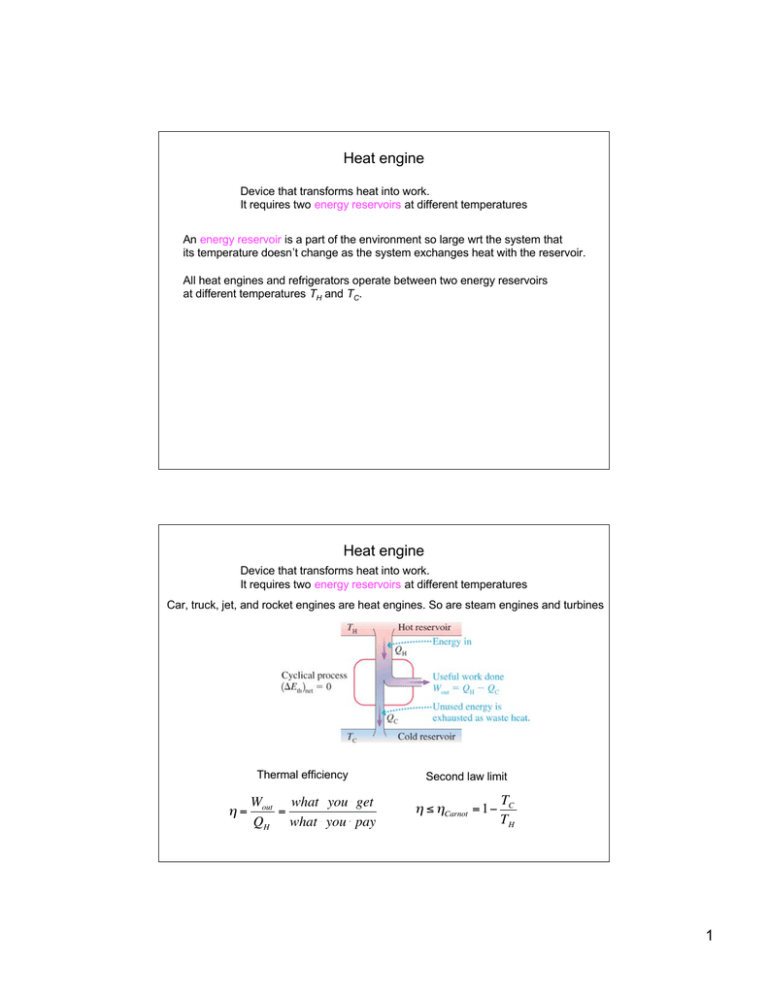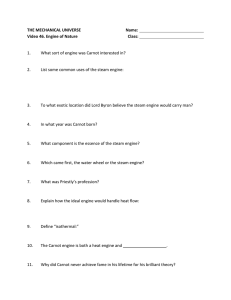Heat engine
advertisement

Heat engine Device that transforms heat into work. It requires two energy reservoirs at different temperatures An energy reservoir is a part of the environment so large wrt the system that its temperature doesn’t change as the system exchanges heat with the reservoir. All heat engines and refrigerators operate between two energy reservoirs at different temperatures TH and TC. Heat engine Device that transforms heat into work. It requires two energy reservoirs at different temperatures Car, truck, jet, and rocket engines are heat engines. So are steam engines and turbines Thermal efficiency η= € Second law limit Wout what i⋅ you i⋅ get = QH what i⋅ you ⋅i pay η ≤ ηCarnot = 1− TC TH € 1 refrigerator Device that uses work to transfer heat from a colder object to a hotter object. Coefficient of performance K= € QC what i⋅ you i⋅ get = Win what i⋅ you ⋅i pay Second law limit K ≤ K Carnot = TC TH − TC € reversible engine A perfectly reversible engine (a Carnot engine) can be operated either as a heat engine or a refrigerator between the same two energy reservoirs, by reversing the cycle and with no other changes. A Carnot engine has max. thermal efficiency, compared with any other engine operating between TH and TC. A Carnot refrigerator has max. coefficient of performance, compared with any other refrigerator operating between TH and TC. € A Carnot cycle for a gas engine consists of two isothermal processes and two adiabatic processes. ηCarnot = 1− K Carnot = TC TH TC TH − TC € tools 2 Work Ws done by the system Ws = –W = area under the pV curve Steam turbines A steam turbine is a mechanical device that extracts thermal energy from pressurized steam, and converts it into useful mechanical work. 90% of the world electricity is produced by steam turbines. Steam turbines, jet engines and rocket engines use a Brayton cycle 3 Steam turbines MG&E, the electric power plan in Madison, boils water to produce high pressure steam at 400°C. The steam spins the turbine as it expands, and the turbine spins the generator. The steam is then condensed back to water in a Monona-lake-water-cooled heat exchanger, down to 20°C. Steam turbines MG&E, the electric power plan in Madison, boils water to produce high pressure steam at 400°C. The steam spins the turbine as it expands, and the turbine spins the generator. The steam is then condensed back to water in a Monona-lake-water-cooled heat exchanger, down to 20°C. What is the maximum possible efficiency with which heat energy can be converted to electrical energy? ηCarnot = 1− TC 293 = 1− = 0.44 = 44% TH 673 This is an upper limit: the real efficiency of MG&E is between 30-40% € 4 Brayton-cycle refrigerator gggg adiabats Stirling engines The SES solar Stirling system the Stirling cycle isotherms 1 2 4 3 5 Stirling Engine (Beta-type) the Stirling cycle isotherms 1 2 PP 4 3 DP Power piston (PP) has compressed the gas, the displacer piston (DP) has moved up so that most of the gas is adjacent to the hot heat exchanger. The heated gas increases its pressure (1) and pushes the PP up along the cylinder (2). This is the Ws>0 expansion, or power stroke. The DP piston moves to shunt the gas to the cold end of the cylinder (3). The cooled gas is now compressed by the flywheel momentum (4). This takes less work than -Ws, because when the gas cooled its pressure also dropped. Animated version. Note that PP lags DP by 90°. In this design the displacer piston shaft passes through the power piston in a gas proof sleeve. In addition, and internal heat exchanger called the regenerator increases the efficiency, up to ~40%! Internal combustion engine: gasoline engine A gasoline engine utilizes the Otto cycle, in which fuel and air are mixed before entering the combustion chamber and are then ignited by a spark plug. Four-stroke cycle 1. intake 2. compression 3. power stroke 4. exhaust the Otto cycle adiabats 6 Internal combustion engine: Diesel engine A Diesel engine uses compression ignition, a process by which fuel is injected after the air is compressed in the combustion chamber causing the fuel to self-ignite. the Diesel cycle Internal combustion engine Two-stroke cycle 1. intake and compression 2. power stroke and exhaust A two-stroke engine, in this case with an expansion pipe, illustrates the effect of a reflected pressure wave on the fuel charge. This feature is present in most high performance engine designs. 7 A typical single cylinder, simple expansion steam engine Flywheel Eccentric valve motion Crank Centrifugal governor Connecting rod Crosshead bearing Piston rod Piston Sliding valve Locomotive Steam Engine In practice, a steam engine exhausting the steam to atmosphere will have an efficiency (including the boiler) of 1% to 8%, but with the addition of a condenser and multiple expansion engines the efficiency may be greatly improved. A simplified triple-expansion engine. High-pressure steam (red) enters from the boiler and passes through the engine, exhausting as low-pressure steam (blue) to the condenser. Efficiency is 25% or better. 8


